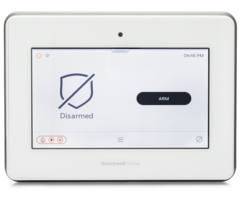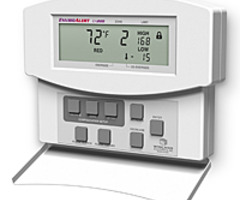How Do I Monitor the Temperature of My Pool or Hot Tub On a PROA7PLUS?
You can monitor the temperature of your poor or hot tub on a PROA7PLUS by integrating a digital programmable temperature sensor with the system. This will require a compatible wireless transmitter like a Honeywell PROSIXCT. Compatible waterproof probes for the sensor will also be needed.

Monitoring pool or hot tub water temperature using an alarm system requires a somewhat intricate setup. A digital temperature sensor that allows the user to set custom high-low temperature limits is essential to accomplishing this. One such sensor that makes this possible is the Winland EA400. Other digital temperature sensors may also work, but the Winland EA400 is the recommended model for those buying their equipment from Alarm Grid. If you are proceeding with the Winland EA400, refer to its installation manual here or this helpful FAQ.
This equipment requires two (2) waterproof probes that are inserted into the water to continuously monitor the temperature. If you are wondering why two probes are required, it's because one is used for low-temp triggers, and the other is used for high-temp triggers The Winland EA400 does not come with any probes included, so you will need to buy your own compatible probes, such as the Winland TEMP-L-W, for the job. It's perfectly fine to use two probes of the same model. If you are using a different temperature sensor, then find out if it comes with waterproof probes, and buy compatible probes if necessary. Also remember that while the probe may be waterproof, the digital temperature sensor will most likely not enjoy that same luxury. Make sure to install the sensor in a location that is protected against the weather, such as inside a pool house or underneath a cover of some kind.
The digital temperature sensor must be integrated with your PROA7PLUS System for the setup to work. This can typically be done by connecting the digital temperature sensor with a wireless transmitter, and then enrolling the wireless transmitter with the PROA7PLUS. This will obviously require you to use a wireless transmitter that is supported by the PROA7PLUS. An example of a model you can use is the Honeywell Home PROSIXCT. If your PROA7PLUS does not support local end user programming, then you will need to ask your monitoring company to help you enroll the sensor. As of January 2021, end-user programming has not yet been added to the PROA7PLUS System. Remember that you may also need to wire-in a power supply and backup battery with the wireless transmitter, as the digital temperature sensor may require these add-ons for power. Other digital temperature sensors may come with their own standalone power supply for this job. Check the product manual for more info.
To break down the setup, the waterproof probes are connected with the digital temperature sensor. These probes are placed into the water to measure its temperature. If a probe detects a temperature outside of its set high-low limits, then the temperature sensor will activate. The connected wireless transmitter will then alert the PROA7PLUS to the issue. The system will then respond based on the programming settings for the zone. If you do not have access to local end-user programming, then these programming settings must be configured by your alarm monitoring company. This zone will typically use a 24-Hour Auxiliary Response Type. Your monitoring company should note on the central station document that this zone is for monitoring the temperature of a pool or hot tub.
Complete the following steps to monitor your pool or hot tub using a PROA7PLUS:
1. Mount sensor and probes. The first thing to do is mount the temperature sensor. The sensor should be installed in a location that is considered safe, based on the installation guidelines outlined in the product's manual. Keep in mind that the digital sensor may not be waterproof. Pay close attention to the operating temperature and relative humidity limits. Also, remember that the attached probes will need to reach the water. You can attach the waterproof probes to complete this step.
2. Connect transmitter and power. You can now connect the wireless transmitter to the digital temperature sensor. Again, a good wireless transmitter to use with the PROA7PLUS is the PROSIXCT. Please refer to the manuals for both the wireless transmitter and the temperature sensor if you are confused or need additional explanation on how to complete the connection. You may need to include a power supply and backup battery in the connection, but some temperature sensors may use their own power supply to overcome this requirement. Power should be supplied to the equipment at this time.
3. Set temperature limits. On the digital temperature sensor, set the high and low limits that you will monitor for. Keep in mind that if the detected water temperature goes outside these limits, then your system will be alerted. Refer to the installation manual to learn how to adjust temperature limits for the digital temperature sensor.
You must also configure the temperature sensor output to the wireless transmitter. You should configure the zone output to work with the wireless transmitter that is being used. For the PROSIXCT, the zone output should be configured and wired as a Normally Closed device.
4. Enroll transmitter to PROA7PLUS. The wireless transmitter should now be enrolled to the PROA7PLUS System. You can do this yourself if your panel supports local end-user programming. But as of January 2021, this feature is not yet available for the PROA7PLUS. Assuming that your PROA7PLUS does not support this feature, you must contact your monitoring company and have them help you add the sensor. They will help you do this. If you are monitored with Alarm Grid, then the best way to contact our support team is via email at support@alarmgrid.com.
Remember that the standard Response Type selection for this setup is 24-Hour Auxiliary. You should make sure that your central station document mentions that this zone is for a pool or hot tub. This is important whether you enrolled the sensor yourself, or if your monitoring company did it for you. If you added the sensor yourself, then please reach out to your monitoring company to let them know about the added 24-Hour Auxiliary Zone. If your monitoring company added the sensor for you, then just simply ask and make sure that they added the information to your central station document. Failing to provide this information could result in a central station operator accidentally thinking that this is a medical alert zone. This is because 24-Hour Auxiliary is also the zone type most often used for Medical Panic Alarms.
Did you find this answer useful?
We offer alarm monitoring as low as $10 / month
Click Here to Learn MoreRelated Products


- Answered

